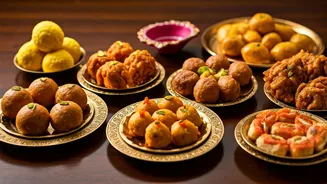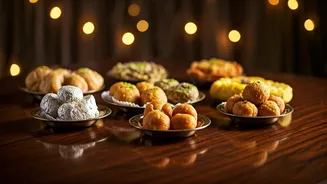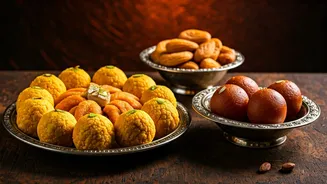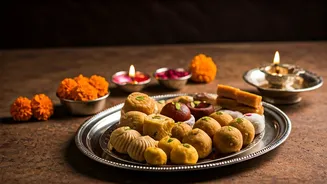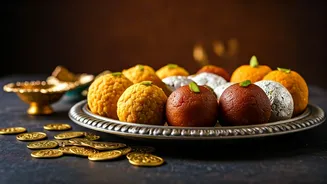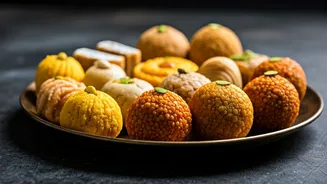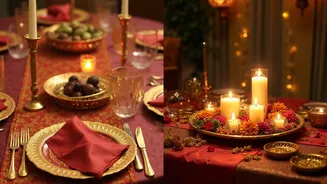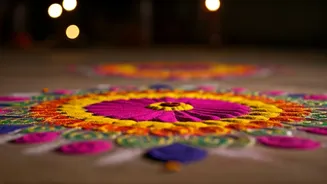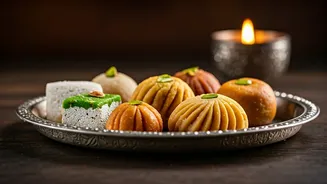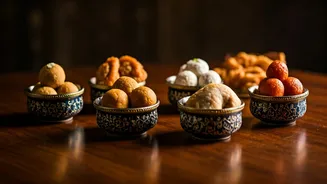Introduction: Diwali's Delights
Diwali is a celebration filled with joy, and food plays a pivotal role in this festive occasion. It is customary to offer specific foods to Goddess Lakshmi
and Lord Ganesha as part of the rituals. These offerings are believed to bring prosperity, happiness, and blessings to the devotees. Each dish carries a unique significance and is prepared with utmost devotion, reflecting the reverence for the deities. This article is all about the foods that are dear to Lakshmi and Ganesha, and should be offered to them to receive their blessings.
Ladoos: Sweet Beginnings
Ladoos, especially the Motichoor and Besan varieties, are a staple offering. Lord Ganesha's love for ladoos is well-known. These round, sweet treats symbolize prosperity and happiness. The preparation of ladoos involves carefully mixing ingredients and shaping them into perfect spheres, a process that requires skill and patience. The vibrant colors and rich flavors of ladoos also add to the festive atmosphere. Their sweetness symbolizes the joy and sweetness of life, and offering them is a way of seeking blessings for a sweet and prosperous year. Ladoos are easily the most famous food item offered to Ganesha, and it's almost impossible to imagine Diwali celebrations without them.
Kheer: Rice Pudding's Grace
Kheer, a creamy rice pudding, holds a special place in the hearts of devotees. Often flavored with cardamom, saffron, and nuts, kheer symbolizes purity and abundance. Its creamy texture and delicate flavors make it a delightful offering to Goddess Lakshmi, who represents wealth and prosperity. The preparation of kheer varies across regions, with each household adding its unique touch. Serving kheer during Diwali signifies a wish for a life filled with blessings and a smooth, fulfilling journey. The making of Kheer also usually involves stirring it over the fire for a long time, thus, symbolizing the patience and persistence that we must have for a good life.
Halwa: A Golden Offering
Halwa, made with semolina, wheat flour, or carrots, is another popular offering. Its golden color represents wealth and auspiciousness, making it a fitting offering to Goddess Lakshmi. Halwa is often garnished with nuts and dried fruits, enhancing its flavor and visual appeal. The aroma of halwa cooking in the kitchen fills the home with warmth and positivity. Offering halwa is a way to express gratitude and seek blessings for a prosperous future. The variety of halwa made also varies, with each community having their own special recipes.
Puri-Sabzi: Traditional Pairing
Puri and sabzi (vegetable curry) form a classic combination during Diwali. Puris, deep-fried puffed bread, symbolize prosperity and abundance. Sabzi, often made with seasonal vegetables, adds a nutritious element to the meal. This combination is a complete meal, offering both substance and satisfaction. Offering puri-sabzi represents a balanced life, seeking blessings for both material and spiritual well-being. This traditional pairing often brings a sense of nostalgia for those who grew up enjoying this festive meal.
Barfi: Milk-Based Delight
Barfi, a dense milk-based sweet, is another favourite. Made from condensed milk and flavored with cardamom, saffron, or nuts, barfi is a symbol of purity and devotion. Its rich texture and creamy taste make it a delightful offering to both Lakshmi and Ganesha. The preparation of barfi involves slow cooking the milk solids until they reach the desired consistency. Offering barfi is a way to express gratitude and seek blessings for a sweet and fulfilling life. Barfi comes in many variations, and the variety of flavors further adds to its appeal.
Modak: Ganesha's Preference
Modak, a sweet dumpling, is particularly dear to Lord Ganesha. These sweet dumplings are typically filled with coconut and jaggery and steamed or fried to perfection. The shape of modak is also symbolic, with its pointed top representing the potential of spiritual growth. Offering modak during Diwali is a way to honor Ganesha and seek his blessings for wisdom and success. Their presence on the Diwali table is almost a must, and it also adds a level of diversity to the many other sweet dishes that are present during the celebrations.
Kaju Katli: Cashew Perfection
Kaju Katli, a diamond-shaped cashew sweet, is another offering associated with Diwali. Made from cashew paste and sugar syrup, Kaju Katli is a symbol of wealth and prosperity. Its smooth texture and rich flavor make it a luxurious treat. Offering Kaju Katli represents a desire for a prosperous and successful life. Its presence adds to the richness of the Diwali feast. Kaju Katli, with its silver leaf topping, is an indulgent offering, and shows the prosperity and wealth that the devotee is seeking.
Peda: Milk Sweetness
Peda, a milk-based sweet, is a popular offering during Diwali. It symbolizes purity and devotion. Peda is often flavored with cardamom and saffron, adding a delicate aroma and flavor. Offering peda is a way to seek blessings for a pure and fulfilling life. Each Peda is skillfully made, and the shape is also a representation of a good, fruitful life. Its soft texture and delicious taste make it a beloved treat. Peda is a simple yet elegant sweet that is perfect for offering during Diwali celebrations, representing a heartfelt devotion to the deities.
